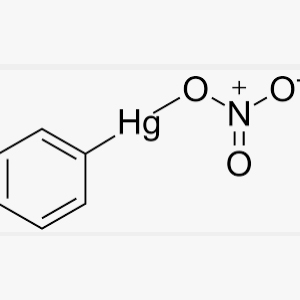
Mercury, (nitrato-O)phenyl-.
Nitratophenylmercury --- [55-68-5].
Phenylmercuric Nitrate is a mixture of phenylmercuric nitrate and phenylmercuric hydroxide containing not less than 87.0 percent and not more than 87.9 percent of phenylmercuric ion (C6H5Hg+), and not less than 62.75 percent and not more than 63.50 percent of mercury (Hg).
Identification:
A: Add 3 mL of sulfuric acid to 0.1 g of it: the mixture becomes yellow, and the characteristic odor of nitrobenzene is evolved.
B: To 5 mL of a saturated solution of it add 1 mL of 3 N hydrochloric acid: a white precipitate is formed.
C: To 5 mL of a saturated solution of it add 5 mL of ammonium sulfide: there is no reaction in the cold, but upon heating in a boiling water bath for 10 minutes a black precipitate is formed.
Residue on ignition: not more than 0.1%.
Mercury ions: To 5 mL of a saturated solution add 5 mL of 1 N sodium hydroxide: no yellow precipitate is formed (mercuric ions) and the solution does not darken (mercurous ions).
Assay for phenylmercuric ions: Transfer about 200 mg, accurately weighed, to a conical flask, and dissolve in 90 mL of water and 10 mL of nitric acid. Add 2 mL of ferric ammonium sulfate, and titrate with 0.05 N ammonium thiocyanate. Each mL of 0.05 N ammonium thiocyanate is equivalent to 13.88 mg of phenylmercuric ion (C6H5Hg+).
DEFINITION
Mixture of phenylmercuric nitrate (C6H5HgNO3; Mr 339.7) and phenylmercuric hydroxide (C6H5HgOH; Mr 294.7).
Content: 62.5 per cent to 64.0 per cent of Hg (Ar 200.6) (dried substance).
CHARACTERS
Appearance: White or pale yellow powder.
Solubility: Very slightly soluble in water and in ethanol (96 per cent), slightly soluble in hot water. It dissolves in glycerol and in fatty oils.
IDENTIFICATION
A. To 5 ml of solution S add 8 ml of water and 0.1 ml of sodium sulphide solution. A white precipitate is formed that darkens slowly on heating.
B. To 1 ml of a saturated solution of the substance to be examined add 1 ml of dilute hydrochloric acid. A white, flocculent precipitate is formed.
C. To 5 ml of solution S add 1 ml of dilute hydrochloric acid, 2 ml of methylene chloride and 0.2 ml of dithizone solution. Shake. The lower layer is orange-yellow.
D. About 10 mg gives the reaction of nitrates.
TESTS
Solution S: To 0.1 g add 45 ml of water and heat to boiling with shaking. Cool, filter and dilute to 50 ml with water.
Appearance of solution: Solution S is colourless.
Inorganic mercuric compounds: Maximum 0.1 per cent.
Loss on drying: Maximum 1.0 per cent, determined on 1.000 g by drying in vacuo for 24 h.